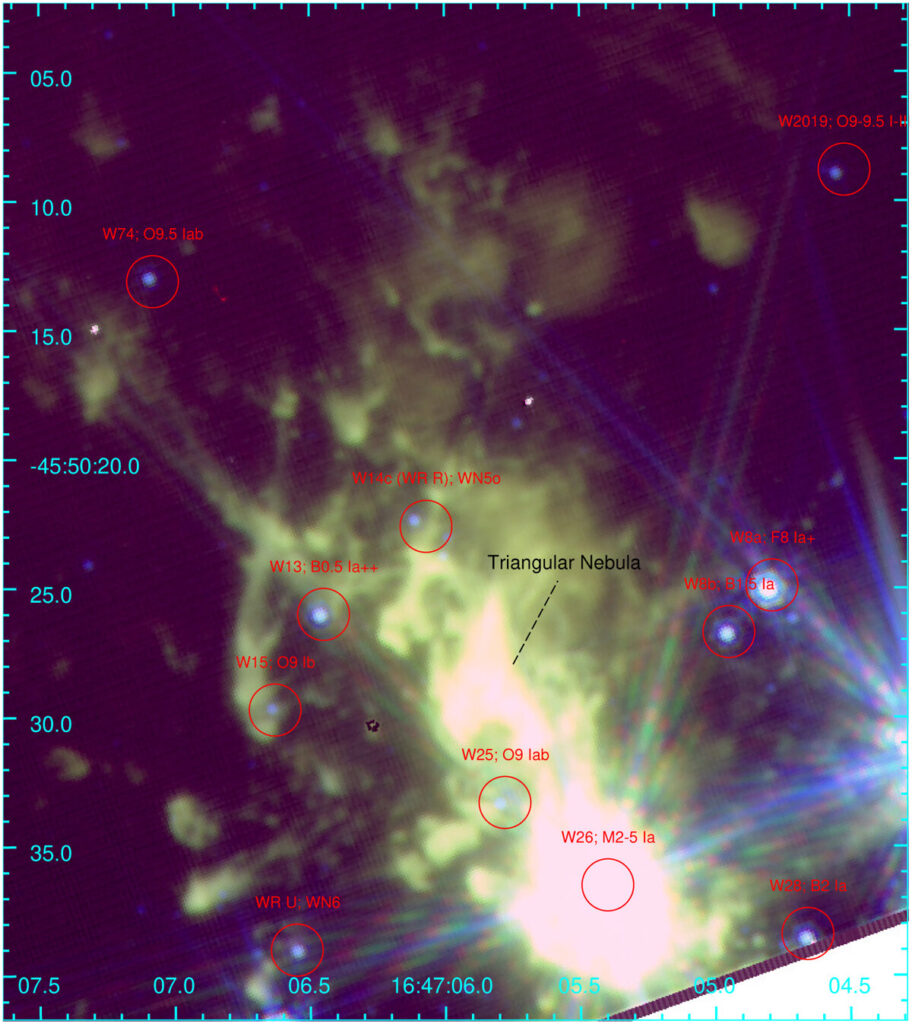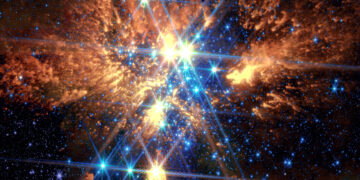The cosmos continues to dazzle us with its grand displays, and the latest revelations from Westerlund 1, one of the Milky Way’s most massive young super star clusters, are no exception. Thanks to NASA’s James Webb Space Telescope (JWST), scientists have unveiled a breathtaking spectacle of stellar fireworks, providing insights into the life and impact of massive stars.
Westerlund 1: A Cosmic Powerhouse
Westerlund 1, located 12,000 light-years away in the Milky Way, is a young yet massive star-forming cluster teeming with activity. Comprising hundreds of massive stars and potentially thousands of lower-mass stars, it serves as a vital laboratory for studying cosmic phenomena.

Astronomers value Westerlund 1 for its uniqueness. It contains rare supergiants and hypergiants, stars that are eight to 100 times the mass of our Sun. These massive stars burn through their fuel quickly, living for only a few million years—a stark contrast to stars like our Sun, which live for billions of years.
JWST’s Revolutionary Observations
The JWST has transformed our ability to study celestial objects, and its observations of Westerlund 1 are a testament to this. Using the Mid-Infrared Instrument (MIRI), the telescope captured intricate details of the gas and dust surrounding the cluster’s massive stars.
The images reveal extended structures known as stellar winds, formed by stars shedding their outer layers. These winds exhibit a surprising variety of shapes, indicating complex interactions between the stars and their environment. Researchers were particularly astonished by the amount of gas and dust retained within the cluster, challenging previous assumptions that massive stars’ radiation would clear these materials.
Kristina Monsch, an astronomer at the Harvard-Smithsonian Center for Astrophysics, noted, “The fact that there is so much dust and gas in Westerlund 1 suggests that massive stars play an important role in shaping their environments, possibly even influencing the formation of stars, similar to our Sun.”
Stellar Winds and Explosive Phenomena
Massive stars like those in Westerlund 1 are known for their dynamic behavior. These stars lose significant mass through powerful winds and explosive outbursts. JWST’s observations reveal how these winds interact with the surrounding gas clouds, creating intricate structures that resemble cosmic fireworks.
The process begins when intense radiation and energy from the stars stir up the gas and dust in their vicinity. This activity not only shapes the morphology of the cluster but also influences its evolution. The stellar winds and radiation from these stars compress gas clouds, potentially triggering the birth of new stars and planets.
The implications are profound. Mario Guarcello, who led the JWST observing campaign, explained, “Westerlund 1 is one of the best testbeds for extending our knowledge of the formation of stars, especially the most massive ones. The observations simply look like a cosmic fireworks display.”
The Role of Massive Stars in Galactic Evolution
Massive stars are cosmic game-changers. Their immense energy and short lifespans leave an indelible mark on their environments. As these stars age, they undergo explosive deaths as supernovae, dispersing heavy elements into space. These elements are the building blocks for planets and, ultimately, life.
In Westerlund 1, only one supernova has been observed so far, but astronomers predict over 1,500 will occur in the coming tens of millions of years. These supernovae will likely shape the cluster’s future and influence the surrounding galactic region.
What This Means for Astronomy
The findings from Westerlund 1 have far-reaching implications for astrophysics. They provide critical data on the dynamics of massive star clusters and their role in the broader galactic ecosystem. The observations also highlight the importance of JWST in uncovering hidden details of the universe.
Joshua Bennett Lovell, who co-led the analysis of the JWST data, remarked, “The discovery of these extended winds surrounding the massive stars in Westerlund 1 was only possible because we stared at the region for over six hours. But the time investment was worth the reward.”
A Future Bright with Possibilities
Westerlund 1 serves as a reminder of the universe’s complexity and beauty. The insights gained from studying this super star cluster extend beyond astronomy, touching on fundamental questions about the nature of our existence and the origins of life.
As JWST continues to unveil the cosmos, its observations will undoubtedly inspire awe and curiosity. By studying the dramatic interactions in clusters like Westerlund 1, we move closer to unraveling the mysteries of the universe and our place within it.
Reference:



















